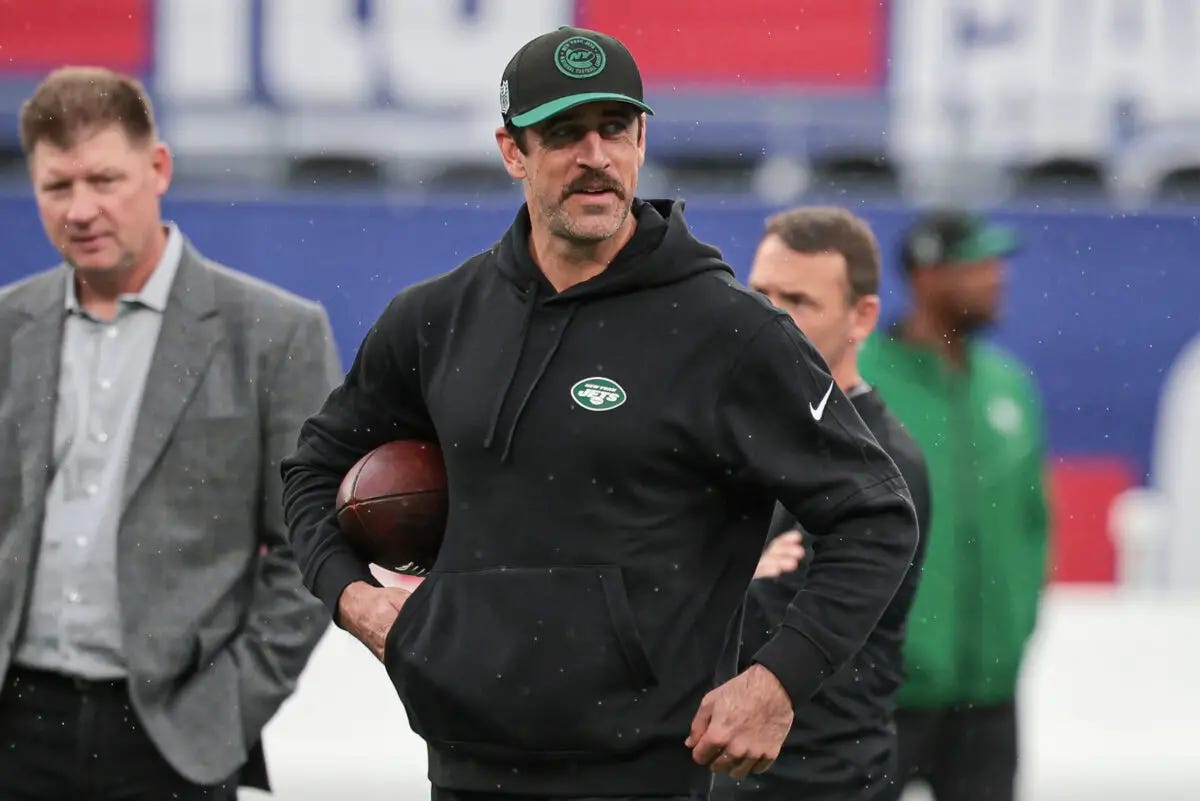Superforecasting: Aaron Rodgers Update
Jets Quarterback is Putting Much More Weight Through his Left Achilles

Last weekend the NY Jets played the NY Giants in an all New York NFL match-up. Aaron Rodgers was on the Jets sidelines again watching his team win 13-10 in overtime. More importantly for us at Absolute was what occurred before the game as Rodgers was again seen throwing the football.
As we noted in our last post on this subject, throwing the football is something that Rodgers has been doing for a couple of weeks now. The significance of this most recent throwing session is that Rodgers is now dropping back, moving his feet in tandem and putting much more weight on his recovering left side.

This signals for us at Absolute:
Pain in the injured Achilles is not an issue and is not a limiting factor to his ability to move.
Now 7 weeks post surgery it is obvious that the SpeedBridge as well as training inputs have helped to create the base tissue architecture of the Achilles.
Behaviourally, the Achilles and the connective tissue continuations that form its linkages demonstrate a baseline of stiffness required to transmit and dissipate forces. Rodgers is able to undergo both (some) length and tension through the Achilles. It is observable that he is not going through the full range of motion, however this is an extremely good sign.
Mechanically, Rodgers technique, although still early in his return to throwing looks sound.
He is doing high percentage bodyweight walking and calve raises - dynamically loading the Achilles albeit in low load scenarios.
Aaron Rodgers’ Subjective Information Flow
At the 6:50 mark, Rodgers discusses how playing this year is still the aim - aligning with our forecast. He also provides insight into his progress in the return-to-performance process, revealing that he has advanced to a stage where he's incorporating high-percentage bodyweight walking and calf raises into his training. Furthermore, from this interview and the video showcasing him throwing, it's evident that his connective tissue's load-bearing capacity is nearing the point of relative bodyweight loading capacity, marking a significant achievement in this process.
“Stressing not Stretching”
In past interviews, Rodgers has emphasized a strategy of 'stressing' the Achilles tissue without 'stretching' it. He also mentions using orthotics in his shoes to limit stretching and facilitate more of the loading component, as the ‘stress’ is obviously the intent at this point. We interpret this approach as consistent with the length loading progression we've discussed previously. This loading progression for connective tissue begins with incorporating repetitive low intensity isometrics as a way to signal the macro-scale tissue as well as its micro-scale constituents (cellular material). As a result of the length being controlled (therefore is a control parameter) by him wearing special orthotics and shoes, it allows Rodgers to continually load the tissues with high frequency eliciting a large response from the biological tissue system. It would be our assumption based on a logical progression that gradually as more tissue stiffness is acquired the length at which he is loading his Achilles will increase.
These isometrics done at length offer several advantages for strength practitioners. They allow precise control over training parameters such as the isometric position, effort level, and duration of work. When combined with more dynamic treadmill work and muscle training like calf raises, it's highly likely that Rodgers training work is stimulating the various ecosystems we've discussed that comprise Point B, as well as targeting the main types of tissue within the biological system (CT and muscle). The simultaneous training of these different ecosystems in a weekly block aligns with the conjugate periodization - an effect way to scale training work.
We Want to Hear Your Feedback
As is the case with super forecasters - with new information our priors need to be updated. Based on our weekly intake of information concerning this case, we remain very confident in our forecast for a Rodgers return this season.
We'd love to hear your feedback on Rodgers return to performance process and our forecast, so please feel free to share them in the comments below.



I was very surprised to see him moving that well already so that does bode well.
If playoffs are the goal, starting January 13th, that means an accumulation of nearly four months of connective tissue capacity building.
Is that truly enough time for the load bearing capacity to be fully restored from a biological healing perspective? What is fully restored for him? It was already sub-optimal to begin with. His age is also a major factor in recovery duration, right?
Return to play is one thing. Getting re-injured is a whole different story, especially at the playoff level of competition. I think he’ll get back on the field, play well for a game or two, strain it which will lead to guarding. He’ll continue to play but it will affect his accuracy and ability to evade. Call me a pessimist.
Watching the Speed-Bridge procedural video was quite informative. The speed-bridge will likely become the standard of care repair, at least for athletes with this injury. My assumption it that this procedure appears to be a keystone element to Rogers care/case. Time will tell whether his durability is up to the task, but he looks pretty good, given the post surgical time frame of recovery.